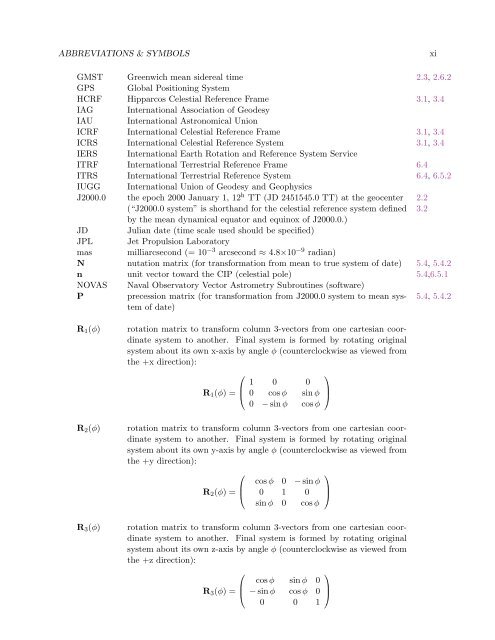USNO Circular 179 - U.S. Naval Observatory
USNO Circular 179 - U.S. Naval Observatory
USNO Circular 179 - U.S. Naval Observatory
You also want an ePaper? Increase the reach of your titles
YUMPU automatically turns print PDFs into web optimized ePapers that Google loves.
ABBREVIATIONS & SYMBOLS xi<br />
GMST Greenwich mean sidereal time 2.3, 2.6.2<br />
GPS Global Positioning System<br />
HCRF Hipparcos Celestial Reference Frame 3.1, 3.4<br />
IAG International Association of Geodesy<br />
IAU International Astronomical Union<br />
ICRF International Celestial Reference Frame 3.1, 3.4<br />
ICRS International Celestial Reference System 3.1, 3.4<br />
IERS International Earth Rotation and Reference System Service<br />
ITRF International Terrestrial Reference Frame 6.4<br />
ITRS International Terrestrial Reference System 6.4, 6.5.2<br />
IUGG International Union of Geodesy and Geophysics<br />
J2000.0 the epoch 2000 January 1, 12h TT (JD 2451545.0 TT) at the geocenter 2.2<br />
(“J2000.0 system” is shorthand for the celestial reference system defined 3.2<br />
by the mean dynamical equator and equinox of J2000.0.)<br />
JD Julian date (time scale used should be specified)<br />
JPL Jet Propulsion Laboratory<br />
mas milliarcsecond (= 10 −3 arcsecond ≈ 4.8×10 −9 radian)<br />
N nutation matrix (for transformation from mean to true system of date) 5.4, 5.4.2<br />
n unit vector toward the CIP (celestial pole) 5.4,6.5.1<br />
NOVAS <strong>Naval</strong> <strong>Observatory</strong> Vector Astrometry Subroutines (software)<br />
P precession matrix (for transformation from J2000.0 system to mean system<br />
of date)<br />
R1(φ) rotation matrix to transform column 3-vectors from one cartesian coordinate<br />
system to another. Final system is formed by rotating original<br />
system about its own x-axis by angle φ (counterclockwise as viewed from<br />
the +x direction):<br />
R1(φ) =<br />
⎛<br />
⎜<br />
⎝<br />
1 0 0<br />
0 cos φ sin φ<br />
0 − sin φ cos φ<br />
R2(φ) rotation matrix to transform column 3-vectors from one cartesian coordinate<br />
system to another. Final system is formed by rotating original<br />
system about its own y-axis by angle φ (counterclockwise as viewed from<br />
the +y direction):<br />
R2(φ) =<br />
⎛<br />
⎜<br />
⎝<br />
cos φ 0 − sin φ<br />
0 1 0<br />
sin φ 0 cos φ<br />
R3(φ) rotation matrix to transform column 3-vectors from one cartesian coordinate<br />
system to another. Final system is formed by rotating original<br />
system about its own z-axis by angle φ (counterclockwise as viewed from<br />
the +z direction):<br />
R3(φ) =<br />
⎛<br />
⎜<br />
⎝<br />
cos φ sin φ 0<br />
− sin φ cos φ 0<br />
0 0 1<br />
⎞<br />
⎟<br />
⎠<br />
⎞<br />
⎟<br />
⎠<br />
⎞<br />
⎟<br />
⎠<br />
5.4, 5.4.2


